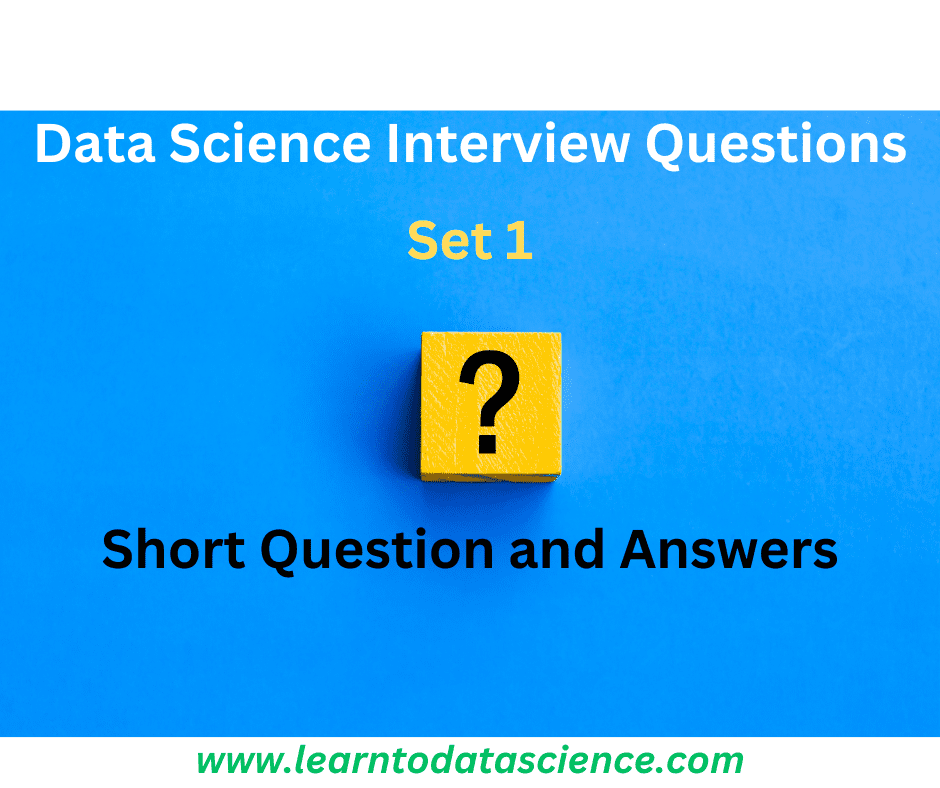Data science is the interdisciplinary field that deals with extracting insights and knowledge from data. It combines techniques from statistics, computer science, and domain-specific fields to analyze and interpret complex data sets, ultimately driving decision-making and innovation.
Skills Needed to Become a Data Scientist
- Proficiency in Python or R programming.
- Strong data manipulation skills using SQL and Pandas.
- Knowledge of machine learning algorithms and statistics.
- Effective communication of complex findings.
- Critical thinking and problem-solving abilities.
- Collaboration in interdisciplinary teams.
- Commitment to continuous learning and adaptation.
Data Science Interview Questions and Answers

What is the purpose of data normalization?
Answer: Data normalization is the process of organizing data to minimize redundancy and dependency.
What is the difference between correlation and covariance?
Answer: Covariance measures the extent to which two variables change together, while correlation standardizes this measure by scaling it between -1 and 1.
Explain the difference between supervised and unsupervised learning.
Answer: In supervised learning, the model is trained on labeled data, while in unsupervised learning, the model is trained on unlabeled data.
What is outlier detection?
Answer: Outlier detection is the process of identifying observations that deviate significantly from the rest of the data.
How would you handle missing data in a dataset?
Answer: Missing data can be handled by methods such as imputation (replacing missing values with a calculated value) or deletion (removing observations with missing values).
What is the purpose of the SQL GROUP BY clause?
Answer: The GROUP BY clause is used to group rows that have the same values into summary rows, typically in conjunction with aggregate functions like SUM, COUNT, AVG, etc.
What is the difference between a LEFT JOIN and an INNER JOIN in SQL?
Answer: An INNER JOIN returns only the rows where there is a match in both tables, while a LEFT JOIN returns all rows from the left table and the matched rows from the right table.
Explain the concept of feature engineering.
Answer: Feature engineering is the process of creating new features from existing ones to improve the performance of machine learning models.
What is the purpose of cross-validation in machine learning?
Answer: Cross-validation is used to assess how well a predictive model generalizes to an independent dataset by splitting the data into multiple subsets.
What is the difference between a histogram and a bar chart?
Answer: A histogram is used to represent the frequency distribution of continuous data, while a bar chart is used for categorical data.
What is a decision tree and how does it work?
Answer: A decision tree is a flowchart-like structure where each internal node represents a decision based on a feature, each branch represents the outcome of the decision, and each leaf node represents a class label.
What is the purpose of principal component analysis (PCA)?
Answer: PCA is used for dimensionality reduction by transforming the original features into a lower-dimensional space while preserving the most important information.
Explain the concept of regularization in machine learning.
Answer: Regularization is a technique used to prevent overfitting by adding a penalty term to the model’s objective function.
What is the purpose of the HAVING clause in SQL?
Answer: The HAVING clause is used to filter groups in the result of a GROUP BY clause based on specified conditions.
What is the difference between a time series and a cross-sectional dataset?
Answer: A time series dataset consists of observations collected over time, while a cross-sectional dataset consists of observations taken at a single point in time.
What is the purpose of a confusion matrix in classification?
Answer: A confusion matrix is used to evaluate the performance of a classification model by summarizing the number of true positives, false positives, true negatives, and false negatives.
What is the purpose of a scatter plot?
Answer: A scatter plot is used to visualize the relationship between two continuous variables by displaying individual data points on a graph.
Explain the concept of feature scaling.
Answer: Feature scaling is the process of standardizing the range of independent variables or features in the dataset.
What is the purpose of a WHERE clause in SQL?
Answer: The WHERE clause is used to filter rows from a table based on specified conditions.
What is the purpose of the k-nearest neighbors (KNN) algorithm?
Answer: The KNN algorithm is used for classification and regression by predicting the class or value of a new observation based on the majority class or average value of its k nearest neighbors.
Explain the concept of data skewness.
Answer: Data skewness refers to the asymmetry or lack of symmetry in the distribution of data.
What is the purpose of the Numpy library in Python?
Answer: The Numpy library is used for numerical computing in Python, providing support for large, multi-dimensional arrays and matrices, along with a collection of mathematical functions.
What is the purpose of the Pandas library in Python?
Answer: The Pandas library is used for data manipulation and analysis in Python, providing data structures like DataFrame and Series for handling tabular data.
Explain the concept of overfitting in machine learning.
Answer: Overfitting occurs when a model learns the noise in the training data rather than the underlying pattern, resulting in poor performance on unseen data.
What is the purpose of the Matplotlib library in Python?
Answer: The Matplotlib library is used for creating static, interactive, and animated visualizations in Python, providing a wide range of plotting functions and customization options.
Data science quiz: Test your knowledge
Read Also:
Top 90+ Data Science Interview Questions and Answers 2024
28 Top Data Scientist Interview Questions For All Levels

